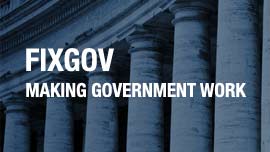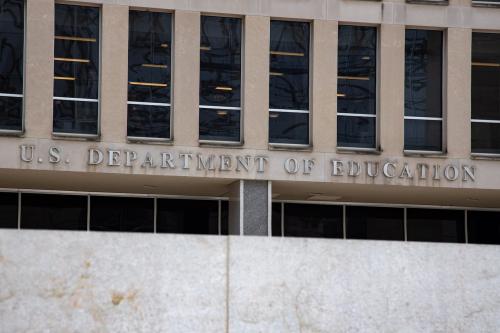A major question about President Donald Trump’s first 100 days of his second term is whether Americans truly want a policy revolution. The chief executive has thought big, pushed through major procedural roadblocks, and implemented extraordinary cutbacks in budget and personnel for key agencies. Americans often voice frustration with big government, waste, fraud, abuse, and undocumented immigration—but do they truly want an administration that rejects policy incrementalism, bypasses Congress to enact major changes, and is willing to shatter long-standing precedents, procedures, and potentially the law itself?
Trump appears to believe the answer to that question is yes. He has framed his presidency as one backed by a massive mandate and has staked his presidency on large-scale policy shifts, tariff wars, and significant staffing cuts across federal programs related to health care, consumer protection, worker safety, environmental regulation, foreign aid, Social Security, and weather forecasting, among many others. The leader of staffing reductions, Elon Musk, has wielded a chainsaw to symbolize the massive scale of the effort he is undertaking.
Reflecting the broad scope of his ambitions to reshape American society, Trump has targeted leading institutions of higher education, major law firms, prominent cultural organizations, and independent nonprofits. He challenged Harvard University—widely regarded as one of the top universities in the world—by threatening its tax-exempt status and its ability to admit international students, and by freezing $2 billion in federal funding. He fired the board of the Kennedy Center for Performing Arts, slashed the budget of the National Endowment for the Humanities, which funds local schools, museums, and historical sites, and went after law firms and nonprofits that provide valuable services to communities across the country.
Procedurally, Trump has employed tactics seldom used by previous political leaders. He has invoked laws dating back more than two centuries—such as the Alien Enemies Act of 1798—to justify the deportation of individuals to foreign countries without any legal hearings. He has urged the Supreme Court to overturn long-standing legal precedents and backed legal arguments aimed at shutting down government-funded entities that have historically received bipartisan support. He has also launched a tariff war that some experts warn could slow economic growth and contribute to inflation.
In pursuing these actions, Trump is aligning himself with the belief that the public desires a dramatic overhaul of the economy and society—not just government—rather than the more incremental policy changes that have characterized most modern presidencies. Previous presidents have typically focused on targeted initiatives: Bill Clinton enacted welfare reform, George W. Bush launched wars in Afghanistan and Iraq, Barack Obama expanded health insurance coverage, and Joe Biden signed a landmark infrastructure bill.
But the scale of Trump’s ambitions surpasses those of recent presidential achievements, resembling the kinds of sweeping societal overhauls more often pursued by authoritarian leaders following military coups or civil conflict. No modern U.S. president has attempted changes as far-reaching as those Trump is now pursuing.
How the public responds to Trump’s sweeping ambitions will serve as a revealing test of political opinion. From both procedural and substantive perspectives, the president appears to be ignoring the historical lesson of the Thermidorian reaction, a concept rooted in the French Revolution: Large-scale revolutions often provoke powerful countermovements and produce substantial, unforeseen consequences. The overthrow of the French monarchy initially gave way to democratic aspirations but ultimately led to a military regime headed by Napoleon. Trump is operating under the assumption that he can fundamentally reshape American politics, society, and the economy without triggering significant protest or jeopardizing his political base.
My sense is that the American public is likely to reject a sweeping policy revolution or a wholesale remaking of the nation’s society and economy. When voters assess political change, they tend to favor adjustments to policies and programs they dislike—not those from which they benefit. Many may applaud bold reforms when they appear to target perceived opponents, but far fewer are likely to support changes that disadvantage their own communities, particularly when they affect schools, hospitals, museums, libraries, and nonprofits they value. They may be suspicious of a future in which imported consumer goods become more expensive, many government services are privatized, and wealthy corporations take jobs through automation, artificial intelligence, machine learning, and data analytics. The coming battles in Congress over Medicaid and the downsizing of Social Security stand out as flashpoints, especially because these programs enjoy broad, bipartisan public support.
The challenge Trump faces is that many of his initiatives are likely to affect people in red states as well as blue ones. They reduce program offerings and public services for conservatives and liberals alike. As individuals come to understand that programs they value are being dismantled—and that their families could face significantly higher personal costs—a countermovement may emerge that surprises Trump and his team with its scale and intensity.
The first test of this dynamic may have already occurred in the Wisconsin Supreme Court election. Although the state is one of the most hotly contested in the country, the liberal candidate defeated the well-funded conservative challenger by 10 percentage points.
Off-year elections this year in Virginia and New Jersey will offer additional evidence on people’s willingness to support large-scale changes that may threaten their own economic interests. The 2026 congressional elections will provide another key test, as Republicans will be defending very narrow majorities—particularly in the House. Losing control of even one chamber could stall Trump’s agenda and significantly reshape the final two years of his presidency.
The Brookings Institution is committed to quality, independence, and impact.
We are supported by a diverse array of funders. In line with our values and policies, each Brookings publication represents the sole views of its author(s).








Commentary
Do Americans really want a policy revolution?
April 17, 2025